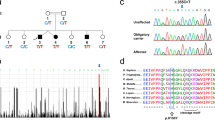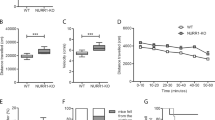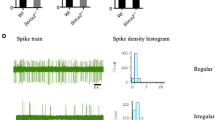Abstract
The dopamine D4 receptor (D4R) is a candidate gene for attention deficit/hyperactivity disorder (ADHD) based on genetic studies reporting that particular polymorphisms are present at a higher frequency in affected children. However, the direct participation of the D4R in the onset or progression of ADHD has not been tested. Here, we generated a mouse model with high face value to screen candidate genes for the clinical disorder by neonatal disruption of central dopaminergic pathways with 6-hydroxydopamine (6-OHDA). The lesioned mice exhibited hyperactivity that waned after puberty, paradoxical hypolocomotor responses to amphetamine and methylphenidate, poor behavioral inhibition in approach/avoidance conflict tests and deficits in continuously performed motor coordination tasks. To determine whether the D4R plays a role in these behavioral phenotypes, we performed 6-OHDA lesions in neonatal mice lacking D4Rs (Drd4−/−). Although striatal dopamine contents and tyrosine hydroxylase-positive midbrain neurons were reduced to the same extent in both genotypes, Drd4−/− mice lesioned with 6-OHDA did not develop hyperactivity. Similarly, the D4R antagonist PNU-101387G prevented hyperactivity in wild-type 6-OHDA-lesioned mice. Furthermore, wild-type mice lesioned with 6-OHDA showed an absence of behavioral inhibition when tested in the open field or the elevated plus maze, while their Drd4−/− siblings exhibited normal avoidance for the unprotected areas of these mazes. Together, our results from a combination of genetic and pharmacological approaches demonstrate that D4R signaling is essential for the expression of juvenile hyperactivity and impaired behavioral inhibition, relevant features present in this ADHD-like mouse model.
This is a preview of subscription content, access via your institution
Access options
Subscribe to this journal
Receive 12 print issues and online access
$259.00 per year
only $21.58 per issue
Buy this article
- Purchase on Springer Link
- Instant access to full article PDF
Prices may be subject to local taxes which are calculated during checkout





Similar content being viewed by others
References
Mrzljak L, Bergson C, Pappy M, Huff R, Levenson R, Goldman-Rakic PS . Localization of dopamine D4 receptors in GABAergic neurons of the primate brain. Nature 1996; 381: 245–248.
Ariano MA, Wang J, Noblett KL, Larson ER, Sibley DR . Cellular distribution of the rat D4 dopamine receptor protein in the CNS using anti-receptor antisera. Brain Res 1997; 752: 26–34.
Tarazi FI, Baldessarini RJ . Brain dopamine D(4) receptors: basic and clinical status. Int J Neuropsychopharmacol 1999; 2: 41–58.
Oak JN, Oldenhof J, Van Tol HH . The dopamine D(4) receptor: one decade of research. Eur J Pharmacol 2000; 405: 303–327.
Fuster JM . The prefrontal cortex-an update: time is of the essence. Neuron 2001; 30: 319–333.
LaHoste G, Swanson J, Wigal S, Galbe C, Wigal T, King N et al. Dopamine D4 receptor gene polymorphism is associated with attention deficit hyperactivity disorder. Mol Psychiatry 1996; 1: 121–124.
Swanson JM, Sunohara GA, Kennedy JL, Regino R, Fineberg E, Wigal T et al. Association of the dopamine receptor D4 (DRD4) gene with a refined phenotype of attention deficit hyperactivity disorder (ADHD): a family-based approach. Mol Psychiatry 1998; 3: 38–41.
Barkley RA . Behavioral inhibition, sustained attention, and executive functions: constructing a unifying theory of ADHD. Psychol Bull 1997; 121: 65–94.
Solanto MV . Attention-deficit/hyperactivity disorder: clinical features. In: Solanto MV, Arnsten AFT, Castellanos X. (ed) Stimulant Drugs and ADHD: Basic and Clinical Neuroscience. Oxford University Press: New York, 2001 pp 3–30.
Solanto MV . Dopamine dysfunction in AD/HD: integrating clinical and basic neuroscience research. Behav Brain Res 2002; 130: 65–71.
Castellanos FX, Tannock R . Neuroscience of attention-deficit/hyperactivity disorder: the search for endophenotypes. Nat Rev Neurosci 2002; 3: 617–628.
Castellanos FX, Giedd J, Marsh WL, Hamburger SD, Vaituzis A, Dickstein D et al. Quantitative brain magnetic resonance imaging in attention-deficit hyperactivity disorder. Arch Gen Psychiatry 1996; 53: 607–616.
Faraone SV, Doyle AE, Mick E, Biederman J . Meta-analysis of the association between the 7-repeat allele of the dopamine D(4) receptor gene and attention deficit hyperactivity disorder. Am J Psychiatry 158: 1052–1057.
Goldman LS, Genel M, Bezman R, Slanetz PJ . Diagnosis and treatment of attention-deficit/hyperactivity disorder in children and adolescents. Council on Scientific Affairs, American Medical Association. JAMA 1998; 279: 1100–1107.
Shaywitz BA, Yager RD, Klopper JH . Selective brain dopamine depletion in developing rats: an experimental model of minimal brain dysfunction. Science 1976; 191: 305–308.
Davids E, Zhang K, Tarazi FI, Baldessarini RJ . Animal models of attention-deficit hyperactivity disorder. Brain Res Brain Res Rev 2003; 42: 1–21.
Gainetdinov RR, Wetsel WC, Jones SR, Levin ED, Jaber M, Caron MG . Role of serotonin in the paradoxical calming effect of psychostimulants on hyperactivity. Science 1999; 283: 397–401.
Zhuang X, Oosting RS, Jones SR, Gainetdinov RR, Miller GW, Caron MG et al. Hyperactivity and impaired response habituation in hyperdopaminergic mice. Proc Natl Acad Sci USA 2001; 98: 1982–1987.
Heffner TG, Seiden LS . Possible involvement of serotonergic neurons in the reduction of locomotor hyperactivity caused by amphetamine in neonatal rats depleted of brain dopamine. Brain Res 1982; 244: 81–90.
Kostrzewa RM, Brus R, Kalbfleisch JH, Perry KW, Fuller RW . Proposed animal model of attention deficit hyperactivity disorder. Brain Res Bull 1994; 34: 161–167.
Zhang K, Davids E, Tarazi FI, Baldessarini RJ . Effects of dopamine D4 receptor-selective antagonists on motor hyperactivity in rats with neonatal 6-hydroxydopamine lesions. Psychopharmacology (Berl) 2002; 161: 100–106.
Rubinstein M, Phillips TJ, Bunzow JR, Falzone TL, Dziewczapolski G, Zhang G et al. Mice lacking dopamine D4 receptors are supersensitive to ethanol, cocaine, and methamphetamine. Cell 1997; 90: 991–1001.
Falzone TL, Gelman DM, Young JI, Grandy DK, Low MJ, Rubinstein M . Absence of dopamine D4 receptors results in enhanced reactivity to unconditioned, but not conditioned, fear. Eur J Neurosci 2002; 15: 158–164.
Gelman DM, Noaín D, Avale ME, Low MJ, Rubinstein M . Transgenic mice engineered to target Cre/LoxP-mediated DNA recombination into catecholaminergic neurons. Genesis 2003; 36: 196–202.
Merchant KM, Gill GS, Harris DW, Huff RM, Eaton MJ, Lookingland K et al. Pharmacological characterization of U-101387, a dopamine D4 receptor selective antagonist. J Pharmacol Exp Ther 1996; 3: 1392–1403.
Volkow ND, Gatley SJ, Fowler JS, Wang GJ, Swanson J . Serotonin and the therapeutic effects of ritalin. Science 2000; 288: 397–401.
Ruskin DN, Bergstrom DA, Shenker A, Freeman LE, Baek D, Walters JR . Drugs used in the treatment of attention-deficit/hyperactivity disorder affect postsynaptic firing rate and oscillation without preferential dopamine autoreceptor action. Biol Psychiatry 2001; 49: 340–350.
Mrini A, Soucy JP, Lafaille F, Lemoine P, Descarries L . Quantification of the serotonin hyperinnervation in adult rat neostriatum after neonatal 6-hydroxydopamine lesion of nigral dopamine neurons. Brain Res 1995; 669: 303–308.
Teicher MH, Anderson CM, Polcari A, Glod CA, Maas LC, Renshaw PF . Functional deficits in basal ganglia of children with attention-deficit/hyperactivity disorder shown with functional magnetic resonance imaging relaxometry. Nat Med 2000; 6: 470–473.
Nigg JT . Is ADHD a disinhibitory disorder? Psychol Bull 2001; 127: 571–598.
Choi S, Lovinger DM . Decreased probability of neurotransmitter release underlies striatal long-term depression and postnatal development of corticostriatal synapses. Proc Natl Acad Sci USA 1997; 94: 2665–2670.
Tang K, Low MJ, Grandy DK, Lovinger DM . Dopamine-dependent synaptic plasticity in striatum during in vivo development. Proc Natl Acad Sci USA 2001; 98: 1255–1260.
Tepper JM, Sharpe NA et al. Postnatal development of the rat neostriatum: electrophysiological, light- and electron-microscopic studies. Dev Neurosci 1998; 20: 125–145.
Werner P, Hussy N, Buell G, Jones K, North R . D2, D3, and D4 dopamine receptors couple to G protein-regulated potassium channels in Xenopus oocytes. Mol Pharmacol 1996; 49: 656–661.
Lanau F, Zenner MT, Civelli O, Hartman DS . Epinephrine and norepinephrine act as potent agonists at the recombinant human dopamine D4 receptor. J Neurochem 1997; 68: 804–812.
Mogenson GJ, Nielsen MA . Evidence that an accumbens to subpallidal GABAergic projection contributes to locomotor activity. Brain Res Bull 1983; 11: 309–314.
Acknowledgements
We thank M Garibaldi, N Malarini, B Wyss and M Ricca for excellent technical assistance and MG Murer and A Ramoj for thoughtful ideas. We thank K Merchant (Pharmacia & Upjohn) for kindly providing PNU-101387G. This work was supported in part by an International Research Scholar Grant of the Howard Hughes Medical Institute (MR), Agencia Nacional de Promoción Científica y Tecnológica (MR), CONICET (MR), Universidad de Buenos Aires (MR), JS Guggenheim Foundation (MR) National Science Foundation (MJL) and National Institute of Drug Abuse (DKG, MJL). ME Avale, T Falzone and D Gelman are recipients of doctoral fellowships of CONICET, Argentina.
Author information
Authors and Affiliations
Corresponding author
Rights and permissions
About this article
Cite this article
Avale, M., Falzone, T., Gelman, D. et al. The dopamine D4 receptor is essential for hyperactivity and impaired behavioral inhibition in a mouse model of attention deficit/hyperactivity disorder. Mol Psychiatry 9, 718–726 (2004). https://doi.org/10.1038/sj.mp.4001474
Received:
Revised:
Accepted:
Published:
Issue Date:
DOI: https://doi.org/10.1038/sj.mp.4001474
Keywords
This article is cited by
-
mGlu5 in GABAergic neurons modulates spontaneous and psychostimulant-induced locomotor activity
Psychopharmacology (2020)
-
Neonatal 6-OHDA lesion model in mouse induces Attention-Deficit/ Hyperactivity Disorder (ADHD)-like behaviour
Scientific Reports (2018)
-
Evolution of sex-specific pace-of-life syndromes: genetic architecture and physiological mechanisms
Behavioral Ecology and Sociobiology (2018)
-
Altered Corticostriatal Connectivity and Exploration/Exploitation Imbalance Emerge as Intermediate Phenotypes for a Neonatal Dopamine Dysfunction
Neuropsychopharmacology (2015)
-
Reinforcement, Dopamine and Rodent Models in Drug Development for ADHD
Neurotherapeutics (2012)



